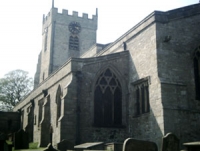The West Kennet Long Barrow
West Kennet Long Barrow is one of the many prehistoric monuments that are part of the Avebury complex of Neolithic sites. It is one of the most impressive and well-preserved burial chambers in Britain, as well as being one of the most visited.
 The mound itself – of which the burial chamber is only a small part – stretches for 100 metres in an East – West orientation. The earth used in its construction was taken from two trenches dug alongside the mound (see diagram), although these have long since become filled with weathered material. The chamber, which extends 10 metres into the mound, consists of five seperate chambers, two on either side of a narrow passage, which then opens up into a further chamber at the far end. Like many of these passage graves, the entrance was flanked by a semi circular forecourt, which framed the dark opening, although this is now partially obscured by the huge stones used to seal the tomb. These large stones, and the other hefty sarcen boulders used in the barrows construction, were brought from the nearby downs, while the smaller stones seem to have been selected and brought from a location over 30 miles away.
The mound itself – of which the burial chamber is only a small part – stretches for 100 metres in an East – West orientation. The earth used in its construction was taken from two trenches dug alongside the mound (see diagram), although these have long since become filled with weathered material. The chamber, which extends 10 metres into the mound, consists of five seperate chambers, two on either side of a narrow passage, which then opens up into a further chamber at the far end. Like many of these passage graves, the entrance was flanked by a semi circular forecourt, which framed the dark opening, although this is now partially obscured by the huge stones used to seal the tomb. These large stones, and the other hefty sarcen boulders used in the barrows construction, were brought from the nearby downs, while the smaller stones seem to have been selected and brought from a location over 30 miles away.
 The tomb is thought to have been constructed around 3500BC, and was in use for a thousand years, until 2200BC, when the tomb was sealed with chalk rubble, and the gigantic sarcen boulders that now guard the entrance. This was at the same time as the great stone circle at Avebury was begun, and may signify a change in the focus of belief and religion.
The tomb is thought to have been constructed around 3500BC, and was in use for a thousand years, until 2200BC, when the tomb was sealed with chalk rubble, and the gigantic sarcen boulders that now guard the entrance. This was at the same time as the great stone circle at Avebury was begun, and may signify a change in the focus of belief and religion.
The tomb was excavated in 1859 and again from 1955 – 56, important evidence is likely to have been lost during the 17th century (when a significant amount of the Avebury circle was destroyed) when it was recorded that the grave had been opened and some of its content removed.
 During excavation it was revealed that almost 50 people – of varied age groups – were buried within the tomb. These people may have been the ruling elite from the farming community that made the Avebury area its home. Evidence also suggests that the bones (specifically leg bones and skulls) were removed for use elsewhere, although the ceremonies, and the meaning of them will probably never be fully understood. It has been suggested that the bodies were first laid out to rot in a separate place, perhaps the sanctuary at nearby Overton, or as part of the complex rituals that took place at Windmill Hill.
During excavation it was revealed that almost 50 people – of varied age groups – were buried within the tomb. These people may have been the ruling elite from the farming community that made the Avebury area its home. Evidence also suggests that the bones (specifically leg bones and skulls) were removed for use elsewhere, although the ceremonies, and the meaning of them will probably never be fully understood. It has been suggested that the bodies were first laid out to rot in a separate place, perhaps the sanctuary at nearby Overton, or as part of the complex rituals that took place at Windmill Hill.
Folklore & Legend
The mound is traditionally visited by a white spectral figure accompanied by a white red-eared hound at sunrise on Midsummer’s day. There is a slim possibility that this tradition is a folk memory of a ritual event or at least a time thought to have been significant in the use of the barrow.
 There is no doubt that some traditions can become convoluted into folklore, and be passed down over the centuries, whether this is the case with West Kennet Long Barrow has never been explored.
There is no doubt that some traditions can become convoluted into folklore, and be passed down over the centuries, whether this is the case with West Kennet Long Barrow has never been explored.
The strange atmosphere of the darkened chamber, and its associations in folklore and legend has led to it being used by modern day pagans and occultists. More about this can be read in the article by Charles Walker here.
Directions: South of the A4 on a dirt trackway, the barrow is visible from the road and Silbury Hill, which stands just next to the A4.



Recent Comments